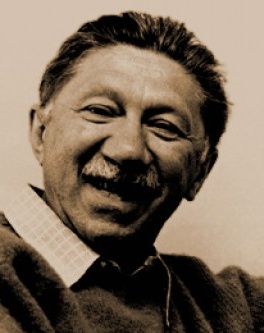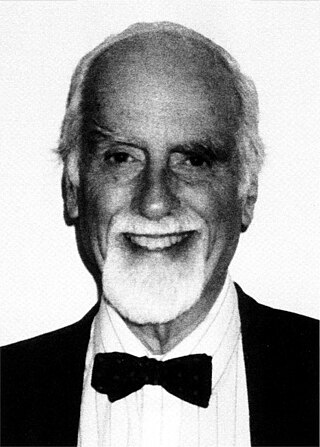Related Research Articles
Personality psychology is a branch of psychology that examines personality and its variation among individuals. It aims to show how people are individually different due to psychological forces. Its areas of focus include:

Maslow's hierarchy of needs is an idea in psychology proposed by American psychologist Abraham Maslow in his 1943 paper "A Theory of Human Motivation" in the journal Psychological Review. Maslow subsequently extended the idea to include his observations of humans' innate curiosity. His theories parallel many other theories of human developmental psychology, some of which focus on describing the stages of growth in humans. The theory is a classification system intended to reflect the universal needs of society as its base, then proceeding to more acquired emotions. The hierarchy of needs is split between deficiency needs and growth needs, with two key themes involved within the theory being individualism and the prioritization of needs. While the theory is usually shown as a pyramid in illustrations, Maslow himself never created a pyramid to represent the hierarchy of needs. The hierarchy of needs is a psychological idea and an assessment tool, particularly in education, healthcare and social work. The hierarchy remains a popular framework, including sociology research, management training, and higher education.
Need for achievement is a person's desire for significant accomplishment, mastery of skills, control, or high standards. The psychometric device designed to measure need-for-achievement, N-Ach, was popularized by the psychologist David McClelland. A need for achievement figures as a secondary or psychogenic need in Henry Murray's system of needs.
Psychology is an academic and applied discipline involving the scientific study of human mental functions and behavior. Occasionally, in addition or opposition to employing the scientific method, it also relies on symbolic interpretation and critical analysis, although these traditions have tended to be less pronounced than in other social sciences, such as sociology. Psychologists study phenomena such as perception, cognition, emotion, personality, behavior, and interpersonal relationships. Some, especially depth psychologists, also study the unconscious mind.

Abraham Harold Maslow was an American psychologist and eugenecist who created Maslow's hierarchy of needs, a theory of psychological health predicated on fulfilling innate human needs in priority, culminating in self-actualization. Maslow was a psychology professor at Brandeis University, Brooklyn College, New School for Social Research, and Columbia University. He stressed the importance of focusing on the positive qualities in people, as opposed to treating them as a "bag of symptoms". A Review of General Psychology survey, published in 2002, ranked Maslow as the tenth most cited psychologist of the 20th century.
Need for power (nPow) is a term that was popularized by renowned psychologist David McClelland in 1961. McClelland's thinking was influenced by the pioneering work of Henry Murray, who first identified underlying psychological human needs and motivational processes (1938). It was Murray who set out a taxonomy of needs, including needs for achievement, power, and affiliation—and placed these in the context of an integrated motivational model. McClelland was inspired by Murray's research, and he continued to further develop Murray's theory by focusing on this theory in regard to the human population. In McClelland's book The Achieving Society, nPow helps explain an individual's imperative to be in charge. According to his work there are two kinds of power, social and personal.
The Thematic Apperception Test (TAT) is a projective psychological test developed during the 1930s by Henry A. Murray and Christiana D. Morgan at Harvard University. Proponents of the technique assert that subjects' responses, in the narratives they make up about ambiguous pictures of people, reveal their underlying motives, concerns, and the way they see the social world. Historically, the test has been among the most widely researched, taught, and used of such techniques.
In psychology, a projective test is a personality test designed to let a person respond to ambiguous stimuli, presumably revealing hidden emotions and internal conflicts projected by the person into the test. This is sometimes contrasted with a so-called "objective test" / "self-report test", which adopt a "structured" approach as responses are analyzed according to a presumed universal standard, and are limited to the content of the test. The responses to projective tests are content analyzed for meaning rather than being based on presuppositions about meaning, as is the case with objective tests. Projective tests have their origins in psychoanalysis, which argues that humans have conscious and unconscious attitudes and motivations that are beyond or hidden from conscious awareness.
Content theory is a subset of motivational theories that try to define what motivates people. Content theories of motivation often describe a system of needs that motivate peoples' actions. While process theories of motivation attempt to explain how and why our motivations affect our behaviors, content theories of motivation attempt to define what those motives or needs are. Content theory includes the work of David McClelland, Abraham Maslow and other psychologists.
The ERG theory is a theory of human need proposed by Clayton Alderfer, which developed Maslow's hierarchy of needs by categorizing needs relating to existence, relatedness and growth.

Henry Alexander Murray was an American psychologist at Harvard University. From 1959 to 1962, he conducted a series of psychologically damaging and purposefully abusive experiments on minors and undergraduate students. One of those students was Ted Kaczynski, later known as the Unabomber.
Dependency need is "the vital, originally infantile needs for mothering, love, affection, shelter, protection, security, food, and warmth."
The theory of positive disintegration (TPD) is an idea of personality development developed by Polish psychologist Kazimierz Dąbrowski. Unlike mainstream psychology, the theory views psychological tension and anxiety as necessary for personal growth. These "disintegrative" processes are "positive", whereas people who fail to go through positive disintegration may stop at "primary integration", possessing individuality but nevertheless lacking an autonomous personality and remaining impressionable. Entering into disintegration and subsequent higher processes of development occurs through developmental potential, including over-excitability and hypersensitivity.

Affect, in psychology, is the underlying experience of feeling, emotion, attachment, or mood. It encompasses a wide range of emotional states and can be positive or negative. Affect is a fundamental aspect of human experience and plays a central role in many psychological theories and studies. It can be understood as a combination of three components: emotion, mood, and affectivity. In psychology, the term affect is often used interchangeably with several related terms and concepts, though each term may have slightly different nuances. These terms encompass: emotion, feeling, mood, emotional state, sentiment, affective state, emotional response, affective reactivity, disposition. Researchers and psychologists may employ specific terms based on their focus and the context of their work.
Developed by psychologist and University of Washington professor Allen L. Edwards, the Edwards Personal Preference Schedule (EPPS) is a forced choice, objective, non-projective personality inventory. The target audience in between the ages of 16-85 and takes about 45 minutes to complete. Edwards derived the test content from the human needs system theory proposed by Henry Alexander Murray, which measures the rating of individuals in fifteen normal needs or motives. The EPPS was designed to illustrate relative importance to the individual of several significant needs and motives. It is useful in counseling situations when responses are reviewed with the examinee.
Self-actualization, in Maslow's hierarchy of needs, is the highest personal aspirational human need in the hierarchy. It represents where one's potential is fully realized after more basic needs, such as for the body and the ego, have been fulfilled. Long received in psychological teaching as the peak of human needs, Maslow later added the category self-transcendence.

Christiana Drummond Morgan was a lay psychologist, artist, and co-director of the renowned Harvard Psychological Clinic. She is best known for co-authoring the Thematic Apperception Test, one of the most widely used projective psychological tests. Morgan played a crucial yet often overlooked role in the development of 20th-century psychology, particularly through her collaboration with Carl Jung and her pioneering work in Jungian and feminist psychology. Her contributions gained renewed recognition with Claire Douglas’s 1993 biography, "Translate This Darkness," and subsequent scholarly interest.

David Clarence McClelland was an American psychologist, noted for his work on motivation Need Theory. He published a number of works between the 1950s and the 1990s and developed new scoring systems for the Thematic Apperception Test (TAT) and its descendants. McClelland is credited with developing Achievement Motivation Theory, commonly referred to as "need for achievement" or n-achievement theory. A Review of General Psychology survey published in 2002, ranked McClelland as the 15th most cited psychologist of the 20th century.
Work motivation is a person's internal disposition toward work. To further this, an incentive is the anticipated reward or aversive event available in the environment. While motivation can often be used as a tool to help predict behavior, it varies greatly among individuals and must often be combined with ability and environmental factors to actually influence behavior and performance. Results from a 2012 study, which examined age-related differences in work motivation, suggest a "shift in people's motives" rather than a general decline in motivation with age. That is, it seemed that older employees were less motivated by extrinsically related features of a job, but more by intrinsically rewarding job features. Work motivation is strongly influenced by certain cultural characteristics. Between countries with comparable levels of economic development, collectivist countries tend to have higher levels of work motivation than do countries that tend toward individualism. Similarly measured, higher levels of work motivation can be found in countries that exhibit a long versus a short-term orientation. Also, while national income is not itself a strong predictor of work motivation, indicators that describe a nation's economic strength and stability, such as life expectancy, are. Work motivation decreases as a nation's long-term economic strength increases. Currently work motivation research has explored motivation that may not be consciously driven. This method goal setting is referred to as goal priming.
Employee recognition is the timely, informal or formal acknowledgement of a person's behavior, effort, or business result that supports the organization's goals and values, and exceeds their superior's normal expectations. Recognition has been held to be a constructive response and a judgment made about a person's contribution, reflecting not just work performance but also personal dedication and engagement on a regular or ad hoc basis, and expressed formally or informally, individually or collectively, privately or publicly, and monetarily or non-monetarily.
References
- 1 2 3 4 5 6 Murray, Henry A (1938). Explorations in Personality. Oxford University Press.
- 1 2 3 4 5 6 Flett, Gordon L (2014). Personality theory and research: an international perspective. Wiley Global Education.
- ↑ Shneidman ES (1996). The Suicidal Mind. Oxford University Press. ISBN 9780195118018.
- ↑ Rosenfeld, Paul; Culbertson, Amy L.; Magnusson, Paul (April 1992). "Human Needs: A Literature Review and Cognitive Life Span Model". Navy Personnel Research and Development Center.
- 1 2 Murray, Henry A (1943). Thematic apperception test. Harvard University Press.
- ↑ Cramer, P (2004). Storytelling, narrative, and the Thematic Apperception Test. New York: Guilford Press.
- ↑ Piotrowski, Nancy A (2010). Salem health: psychology & mental health. Salem Press.
- ↑ Cervone, Daniel; Vittorio Caprara, Gian (2000). Personality: Determinants, Dynamics, and Potentials. Cambridge University Press. p. 348. ISBN 0521587484.